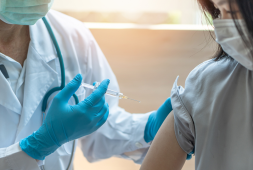
In a recent study, research that involved around 170,000 participants has shed light on the possible disparities in heart health scores among individuals of different sexual orientations.
Notably, the study findings suggest that lesbian and bisexual women may have a lower likelihood of achieving ideal heart health scores compared to heterosexual women. On the other hand, gay or bisexual men exhibited higher heart health measures than their heterosexual counterparts, but this pattern was observed primarily in urban areas.
The study, which was published in the Journal of the American Heart Association on May 17, is the first to assess cardiovascular health disparities within the LGBTQ+ community using the American Heart Association’s (AHA) Life’s Essential 8 checklist among gay, lesbian, and bisexual people, says the researchers.
Study lead author Omar Deraz, MD, a researcher with Inserm, the French National Institute of Health and Medical Research, and the Paris Cardiovascular Research Center’s Integrative Epidemiology of Cardiovascular Disease Team, said in a news release, “Improving these metrics is a great opportunity to prevent heart problems before they happen.”
What Is Life’s Essential 8?
Life’s Essential 8 (LE8) is a set of health behaviors and health factors developed by the AHA that promote good cardiovascular health.
- Eat better. A Mediterranean-type diet that focuses on whole foods (not processed) and eating lots of fruits, vegetables, lean proteins, and healthy fats.
- Be more active. Adults should get 2.5 hours of moderate or 75 minutes of vigorous physical activity per week.
- Quit tobacco. The use of traditional cigarettes, e-cigarettes, and vaping is the leading cause of preventable deaths.
- Get healthy sleep. Most adults need seven to nine hours of sleep each night.
- Manage weight. Achieving and maintaining a healthy weight can help in the prevention of many chronic diseases. Body mass index (BMI), as detailed by the Centers for Disease Control and Prevention (CDC), is one way to gauge weight; between 18.5 and 24.9 is considered the health range.
- Control cholesterol. Heart-healthy cholesterol numbers: total cholesterol of under 200, LDL cholesterol under 100, and HDL cholesterol of 60 and higher, per the Cleveland Clinic.
- Manage blood sugar. High levels of blood sugar can damage the heart, kidneys, eyes, and nerves. An A1C below 5.7 percent is normal, and a fasting blood sugar of 99 milligrams per deciliter (mg/dL) or lower is normal, according to the CDC.
- Manage blood pressure. Optimal blood pressure is 120/80 millimeters of mercury (mm Hg).
LE8 is actually the new version of AHA’s former health initiative called Life’s Simple 7 (LS7). It was just in 2022 that healthy sleep was included as an additional essential health behavior.
Study Finds Lesbians Had Lower Heart Health Scores in High Blood Pressure and Diet
The research drew upon health data from approximately 169,400 adults in France who participated in the nationwide Constances study. Among the participants, 53 percent were women, all free of heart disease, with an average age of 46.
With the female group, 93 percent identified as heterosexual, around 3.5 percent identified as bisexual, and 0.61 percent identified as lesbian. Among the male participants, 90 percent identified as heterosexual, 2.5 percent as bisexual, and 3 percent as gay. Approximately 3 percent chose not to disclose their sexual orientation.
The researchers meticulously accounted for various factors that could influence the results, including family history of cardiovascular disease, age, employment statues, education and household income.
Using AHA guidelines, heart health scores (both LE8 and LS7) were computed in each area and then averaged. Key findings include:
- Lesbian and bisexual women had lower cardiovascular health scores compared with heterosexual women.
- Gay and bisexual men living in urban areas scored higher than heterosexual men, however, those living in rural areas had lower cardiovascular health scores.
- Compared with heterosexual women, lesbian women scored lower for healthy diet and blood pressure. In contrast, bisexual women had higher scores for healthy diet and nicotine exposure.
- Lesbian, gay, and bisexual adults overall reported anxiety disorders, depression symptoms, or attempted suicide more frequently than heterosexual adults, but lesbian women reported fewer anxiety disorders and depression symptoms compared with heterosexual women.
It’s important to note that the study’s applicability to other countries may be limited, as it exclusively focused on participants from France, a high-income country with universal healthcare coverage.
Moreover, the study had a singular focus on assessing cardiovascular health based on sexual orientation, data pertaining to heart health among transgender individuals was not available, as the authors explained.
Clinical assistant professor and board-certified family medicine physician specializing in full-spectrum LGBTQ+ health, Benjamin Laniakea, MD, says, “I think these findings make a lot of sense in light of a few factors, including that the LGBTQ population are much less likely to seek out both mental health care and healthcare in general.”
Notably, Dr. Laniakea, who uses the gender-neutral pronouns they/them, was not involved in this research.
Highlighting the broader context, a 2020 survey conducted by the Center for American Progress (CAP)revealed significant healthcare access challenges within the LGBTQ+ community. This survey of over 1,500 self-identified LGBTQ+ adults indicated that approximately 3 in 10 faced difficulties accessing essential medical care due to cost-related issues, with more than half of transgender individuals experiencing such barriers.
Furthermore, about 15 percent of LGBTQ+ respondents reported a delay or avoiding medical treatment due to discrimination, with nearly 30 percent of transgender individuals impacted.
Discrimination and Stress May Add to Unhealthy Behaviors
As per Dr. Laniakea, many LGBTQ+ individuals report facing stigma and discrimination, which can be quite stressful.
“Most people don’t have to read about whether or not they have the right to exist in the world on a day in and day out basis,” they point out.
“This stress can be a huge mental burden, and some people may turn to things like alcohol, cigarettes, or other unhealthy practices such as overeating, in order to escape,” says Dr. Laniakea.
Disparities Discovered in France May Be Even Greater in U.S.
According to a professor of medicine and cardiologist at Penn Medicine in Philadelphia, Victor Ferrari, MD, said that this is a landmark study since it’s the very first to evaluate the cardiovascular health disparities in those who identify as a sexual minority group.
“Other studies in the past have looked at health disparities in these populations in other areas of health such as sexual or mental health, but this is the first study to actually look at important cardiovascular risk factors such as blood sugar, blood pressure, and cholesterol,” says Dr. Ferrari, who was not involved in the research.
He also points out that when interpreting findings, we should keep in mind that the study was conducted in France, which again, is a country with a national healthcare system.
He adds, “If these discrepancies are present in this type of healthcare environment, where everyone has access to healthcare, and people don’t have to worry about being insured or underinsured, I think the disparities found in this study could be even greater in the United States,” says Ferrari.
Why Were Disparities Found in Gay and Bisexual Women But Not in Gay and Bisexual Men?
The authors weren’t able to discover the “why” behind the results, making it unclear as to why these disparities exist in gay and bisexual women, but not in men.
Dr. Ferrari shares, “I think we need more data, and to make sure we’re not making generalizations to explain the findings, some of which might further perpetuate stereotypes.”
However, Dr. Laniakea gave a potential theory that could help explain the differences found in this study. “This is only speculation, but more recently — in the last 10 or 12 years — there’s been a huge push to get HIV management, PreP management, and STI prevention, and the queer community has rallied around our young gay and bisexual men in getting them to the doctor. In our experience, the cisgender gay population, especially the cisgender white gay population, actually see their doctor — as long as there’s good medical access to care — as often or even more than their peers as opposed to the rest of the LGBTQ population.”
New Interventions Needed to Address Disparities
Connie Tsao, MD, an attending staff cardiologist at Beth Israel Deaconess Medical Center in Boston, said in the news release, “To fully address discrimination and disparities that impact health, we must better recognize and understand the unique experiences of all individuals and populations, including sexual minorities.” Dr. Tsao was also not involved in the new study.
The authors of the 2020 AHA Scientific Statement address cardiovascular health in LGBTQ adults, saying that the evidence that LGBTQ adults, specifically lesbian, bisexual, and transgender women, experience disparities over a number of cardiovascular health metrics.
As per the study authors, to begin to address these gaps, new interventions need to be developed and tested.
They concluded, “Advancing the cardiovascular health of LGBTQ adults requires a multifaceted approach that includes stakeholders from multiple sectors to integrate best practices into health promotion and cardiovascular care of this population.”



